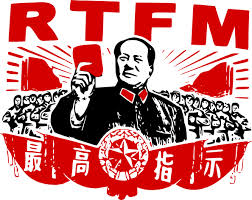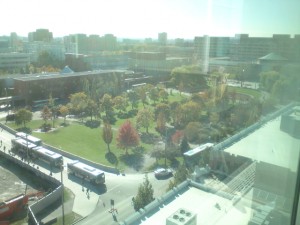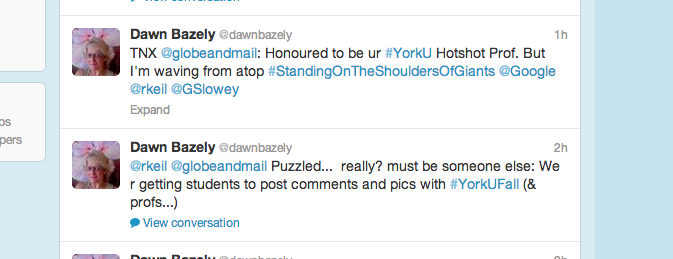Anybody who has given any kind of cursory glance over this website in the last 2 months, will know that webpage construction has rather ground to a halt. The reason for this, is that I have spent a lot of time since mid-September, exploring and experimenting with social media, specifically Twitter.
The impetus for this project, is that it has, naturally, come to my attention that a lot of young people, including university students use Twitter as a main source of news. I had never really understood its appeal or significance. Thanks to the younger generation of students and staff driving the internet presence of IRIS (Institute for Research and Innovation in Sustainability), I had a Twitter account about four years ago, but I never knew what to do with it. Since then, I have gotten to know a couple of people with the job description of "Social Media Co-ordinator" or something like that. They explained to me, that I should not dismiss Social Media out of hand, but rather try to understand and use it better; naturally, in my case, my interest revolves around its usefulness as a research and education tool.
What have I learned about using Twitter?
 The first thing that any good scientist does, is to RTFM and then get the t-shirt. Which means, in the absence of a hard copy Twitter Manual, I have googled and read lots of Help webpages and blogs about, well, Twitter. I learned about hashtags and Twitter-speak or its language. It turns out that there's quite a bit to learn, and I am still learning about Favourites (a good way to bookmark interesting tweets that might link to useful articles)
The first thing that any good scientist does, is to RTFM and then get the t-shirt. Which means, in the absence of a hard copy Twitter Manual, I have googled and read lots of Help webpages and blogs about, well, Twitter. I learned about hashtags and Twitter-speak or its language. It turns out that there's quite a bit to learn, and I am still learning about Favourites (a good way to bookmark interesting tweets that might link to useful articles)
In addition to all kinds of pages that explain the meaning of RT, MT and HT, I also discovered that there is an etiquette to Twitter. I have been trying to act as a good citizen, which mainly seems to mean not "stealing" tweets and being sure to acknowledge the source of good and useful tweets. This, is simply just another form of responsibly attributing sources, like I ask students to do in their lab. reports and essays... In other words, Twitter doesn't like plagiarism either. However, I do think that all this "thanking for retweet" and "thanking for following" is a bit much, but I get that the social dynamic is important (and probably age-related, though I may be wrong about that).
I have also read about Twitter being a disruptive and unexpected Technology. In this, I agree that part of the difficulty with comprehending what to do with Twitter, is that it is used in such different ways by each and every person. The best explanation that I have read about why Twitter is so hard to pigeonhole, is an excellent Techcrunch blog, The Genius of Twitter, by Jon Evans. He describes Twitter as being akin to the "Blind Men and the Elephant" fable. This fable, which originated in the Indian sub-continent, talks about how each of the blind men can touch one part of the elephant, but each has a different experience of it. So, they lack a big, coherent picture. That's a brilliant analogy for Twitter.
What are my conclusions and findings after a month of immersion in the Twitterverse?
1. It really does function as a "canary in the coal mine" news source. This is because, it's basically a customized crowd-sourced newsfeed, for specific topics and much more. I learned that I had been named as York University's Hotshot Professor by the Globe and Mail, in its annual Canadian Universities Report for 2014, from Tweets by Professors Roger Keil and Gabrielle Slowey. And, I thanked the Globe and Mail by Twitter...!
2. It really does reach out to youth and students. There are various sources of analytics and demographic data out there, that tell us that Twitter users are predominantly young and female. I am currently working with a number of grad students, staff and researchers on projects aimed at assessing the state of York's trees and forests. We knew that we wanted to draw attention to the natural environment on the campus. I wondered if Twitter could play a role in this and dreamed up (inspired by and copied from Harvard, actually, and its #HarvardinAutumn campaign - that I learned about from following Harvard Forest on Twitter) the #YorkuFall campaign, with Mark Farmer, our very own "Digital Media Strategist".
 In a couple of weeks, we have amassed an amazing crowd-sourced collection of photos showcasing Fall action on the campus and the beautiful Fall colours to be seen. In other words, there is nature on campus, and people are aware of it. In the next few weeks, Janise Herridge, who is doing her Masters in Forest Conservation at the University of Toronto, will be surveying students, faculty and staff in more detail about the trees and wildlife on the Keele campus.
In a couple of weeks, we have amassed an amazing crowd-sourced collection of photos showcasing Fall action on the campus and the beautiful Fall colours to be seen. In other words, there is nature on campus, and people are aware of it. In the next few weeks, Janise Herridge, who is doing her Masters in Forest Conservation at the University of Toronto, will be surveying students, faculty and staff in more detail about the trees and wildlife on the Keele campus.
3. Twitter is a new and useful way of communicating about science. Two examples of this are a paper by a team led by Simon Fraser University: Darling et al. (2013) The role of Twitter in the life cycle of a scientific publication. A second example is the Twitter Chat in which I participated, on the topic of valuing ecosystems, organized by the Rockefeller Foundation, the World Resources Institute and the Intelligence Unit of the Economist Magazine. I think that the latter is the research arm of the magazine.
Through the #Ecovalue Twitter Chat, participants from around the world, responded to the following, well thought out, pre-set questions (which was very smart of the organizers!):
Question 1: Have environmental damages affected you personally now or over your lifetime? How?
Question 2: Does your community appreciate your natural ecosystems and the services they bring? How?
Question 3: How is your community helping protect or improve ecosystems?
Q4: What are the main obstacles to improving ecosystems in your area and around the world, today and tomorrow?
Q5: What surprises not yet spotted might we expect in the ecosystems area (eg, emerging tech)?
It took me a while to get the hang of giving very succinct answers that included the correct hashtag, but I walked away having connected with 3 new colleagues. In the case of two of them (Biomimicry/Janine Beynius and Dr Stanislav Shmelev), I was aware of their work, but not their recent activity. And, now, I have another book to read, Ecological Economics by Stanislav and am following them on Twitter, as well as a new colleague, Musings4Progress @myhumblemusings who is interested in #FoodSecurity #PowerOfCommunication #Networks #MDGs to #SDGs. COOL!!
OK, so I got hold of the basics. What's next? A research project to investigate how Twitter can help to mobilize ecological knowledge housed in YorkSpace.
Have fun Tweeting!
dawn bazely


